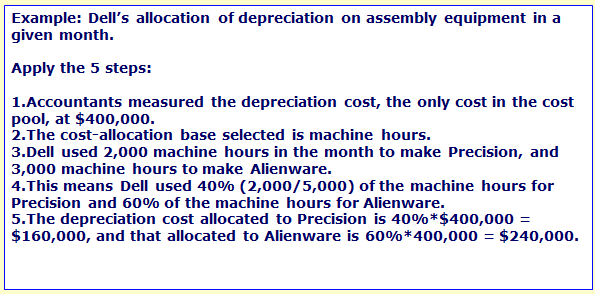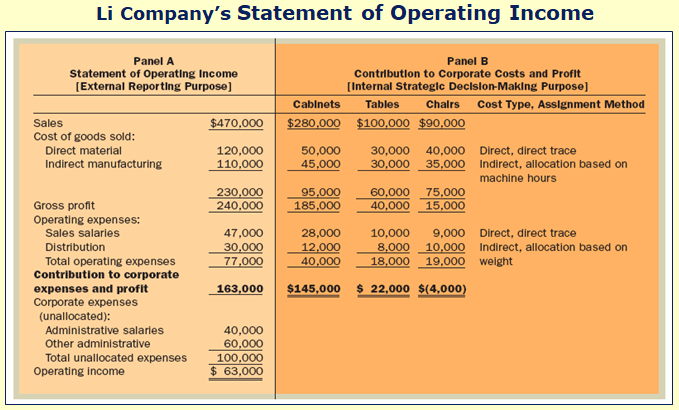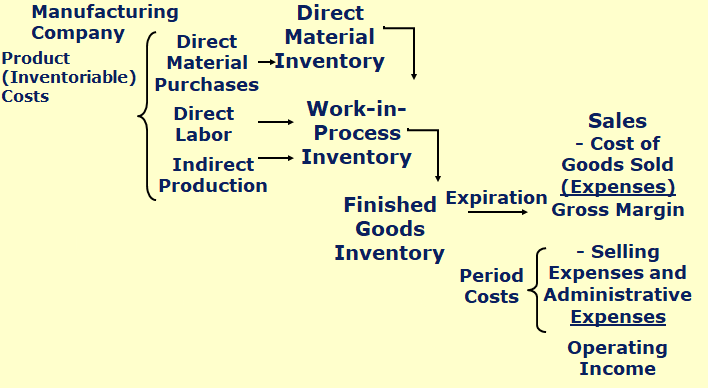Direct Cost
Definition
- identify direct costs specifically and exclusively with a given cost object in an economically feasible way
Characteristics
- physically identify the amount of the cost that relates exclusively to a particular cost object.
tracing the direct cost to the cost object
Indirect Cost
Definition
- Indirect costs cannot be identified specifically and exclusively with a given cost objective in an economically feasible way.
- Assign indirect costs to cost objects
Examples
- facilities rental costs, depreciation on equipment, and many staff salaries
Cost Allcation
Definition
- Cost allocation assigns indirect costs to cost objects, in proportion to the cost object’s use of a particular cost-allocation base.
- base is some measure of input or output that determines the amount of cost to be allocated to a particular cost object.
- 通常就是cost driver
- Why need?
- strategic decision
- operational control
- external reporting
- pruposes:
- predict economic effects
- setting the optimal product and customer mix, pricing policy, chose value-chain function to develop as core competencies
- predict the economic benefits and costs of process improvement efforts
- provide desired motivation and feedback for performance evaluation
- compute income and asset valuations for financial accounting
- justify costs or obtain reimbursement
理想情况下,成本分配应该同时满足四个需求
但是,成本分配通常也是一个迷惑和冲突的主要来源
分配 固定成本 经常造成最大的问题
管理者应该 识别哪个目的是最重要的 “Different cost for different purposes”
- predict economic effects
Example
- Dell:

Selection
- base should be a measure of how much of the particular cost is caused by the cost objective
- At most circumstances: most allocation bases are cost drivers
Method of Allocation Costs
- direct costs: tracing
- indirect costs: allocate using a cost-allocation base
Cost Pool
Definition
- Individual costs allocated to cost objects using a single cost-allocation base.
Steps
- Accumulate indirect costs for a period of time
- select an allocation base
- 计量每一个product使用了多少cost-allocation base
- 按照数量的比例分配cost pool中的成本到单个产品
Examples

Unallocated Cost
- might include R&D, legal design, accounting…
- just leave them alone
Examples

For External Reporting Purposes
- 成本会计系统的目的之一就是提供存货的度量和COGS的度量
- Four Attributes
- Manufacturing costs
- Product versus period costs
- Costs on the balance sheet
- Costs on the income statement
Manufacturing Costs
- Direct-material costs
- Direct-labor costs
- Indirect production costs(Overhead)
Merchandising Company

Manufacturing Company

Comparing
- Current Assets

- Inventory

- COGS

Activity-Based Management
Definition
- Using the output of an activity-based cost accounting system to aid strategic decision making and to improve operational control
- A value-added cost should be included
- Nonvalue-added costs can be eliminated without affecting a product’s value to the customer
Benchmarking
- continuous process of comparing products, services and activities to the best industry standards
Benefits of ABC
- set an optimal product mix
- estimate profit margins of new products
- determine consumption of shared resources
- keep pace with new product techniques
- keep pace with technological changes
- decrease costs associated with bad decisions
- take advantage of reduced cost of ABC systems due to computer technology
To design an ABC system
- Determine the key components of the cost accounting system
- cost objectives(成本对象:比如commercial和residential顾客 )
- key activities(主要要从事哪些业务活动,形成activity dictionary)
- resources (每个activity需要消耗的资源,以及企业本身的资源)
- related cost drivers(成本和行为之间的因果关系,把resource和activity联系起来的,把activity和objective联系起来的成本动因)
- Determine relationships among cost objectives, activities, and resources
- Collect relevant data concerning costs and the physical flow of the cost-driver units among resources and activities
- calculate and interpret the new activity-based information
- determine the traceable costs for each of the activity cost pools
- Determine the activity-based cost for account for each customer class.
Design of a Traditional Costing System
- 将间接成本只按一个cost driver 分配